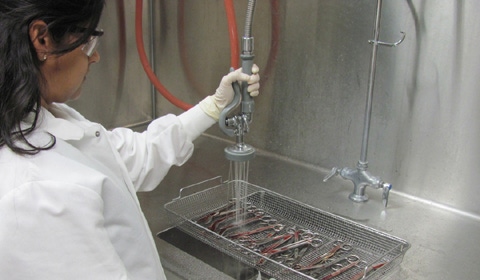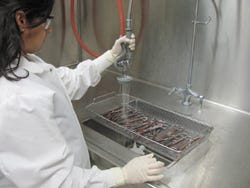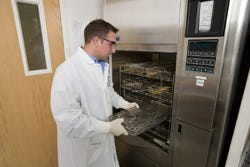The reusable medical device industry is facing a tough decision regarding device design considerations and usability.
July 26, 2012

Today’s demand for more complex devices has led to the introduction of devices that are difficult to reprocess. These design advances are challenging the sterile processing units in hospitals. Often device manufacturers do not give enough consideration to the “human factors” involved in reprocessing a device, including working conditions and individual characteristics of sterile processing personnel which affect work behavior. Complex medical device designs and other enhancements that do not take these human factor considerations into account may make it difficult, or even impossible, for hospitals to clean, disinfect, and re-sterilize these devices in an effective manner.
|
A study director performs a disinfection study. |
FDA Expectations
Infections resulting from improper cleaning and sterilization practices have captured the attention of FDA and the manufacturers of reusable medical devices. These improper cleaning and sterilization practices are often a result of incomplete, unclear, or impractical Instructions For Use (IFU) provided by the device manufacturers. Poorly written IFUs, insufficient training, and limited understanding of the function of the device add to the already difficult challenges faced by the service department personnel. This lack of clear instructions and inadequate training often encourages misinterpretation and may result in insufficient cleaning and sterilization of a medical device.
FDA published a draft guidance document in May 2011 that provides manufacturers with guidelines for writing an IFU.1 The document emphasizes the need to perform parameters commonly used in the clinical setting. By designing devices and processing instructions with cleaning and sterilization in mind, medical device manufacturers can supply IFUs that the end user can easily follow to produce safe instruments in an efficient manner while keeping up with current trends and guidance from FDA.
Need for Consistency
Many healthcare facilities are unable to follow every IFU due to time constraints and the frequent need of devices and trays for surgery. Hospitals reprocess thousands of instruments per day, and asking the sterile processing departments to read each instruction for each device is not feasible. Many times, similar devices from different manufacturers have different reprocessing instructions, which can cause confusion and error in reprocessing.
The current struggle between healthcare facilities and manufacturers has brought increased awareness in the device industry. Hospitals are asking manufacturers to standardize cleaning parameters in a manner similar to standard sterilization cycles to correlate IFUs to contain all necessary instructions for reprocessing similar medical devices. Most cleaning processes are performed manually and therefore, the negative effects of human factors are most prevalent. The use of mechanical and automated cleaning processes has increased with the intent to reduce the problems encountered by human factors. Healthcare facilities and device manufacturers are focusing on reducing manual cleaning methods for safety and operating convenience.
FDA has encouraged collaboration between healthcare facilities and manufacturers to address the problems associated with complex device designs and human factor reprocessing considerations. Additionally, AAMI has started new working groups—WG85: Human Factors for Device Reprocessing, and WG12: Instructions for Reusable Device Reprocessing—in an attempt to address some of these issues from all industry perspectives. However, technology and the need for complex devices are hindering industry harmonization.
Although the need for standardizing sounds possible and may reduce risks associated with reprocessing, it may be a long time before the industry achieves that goal. Because human factor considerations are still a concern in reprocessing of reusable medical devices, we as a team (manufacturers, healthcare facilities, and contract laboratories) should consider human factors during device design, validation, and when writing IFUs.
|
Simulating hospital prerinsing practices for validation. |
Design Considerations
In many cases, reusable device manufacturers do not consider reprocessing until after the design is complete. Provisions for cleaning and sterilization should be considered during the first stages of device design. The following are examples of design considerations that can help manufacturers achieve functional yet cleanable and sterilizable product designs.
Material Type. The type of materials chosen for the device or device container can have a significant effect on thermal conductance which, in turn, can affect optimal sterilization conditions. Materials such as braided cables, aluminum based metals, and pliable materials (silicone and rubber) may decrease the ability to clean a device. Material compatibility with sterilization methods, alkaline detergents, or chemical disinfectants must also be considered as outlined in AAMI TIR 30:2011.2
Design features. Inaccessible areas of a device pose a potential challenge for effective reprocessing. When designing devices, consider finding alternatives to the following:
Textured surfaces.
Hinges.
Springs.
Narrow or dead end lumens.
Cracks and crevices.
Mated surfaces.
Unfortunately, these design features are often unavoidable. However, manufacturers must recognize that these design features will require more stringent cleaning procedures such as mechanical or automated cleaning methods. These types of features also have the potential to increase sterilization cycle times or drying times.
What to Think About During Validation
FDA has started to include human factor considerations in validations to simulate real-life scenarios in healthcare settings. By creating a worst-case clinically relevant environment, the validations have become more difficult, causing challenges that may make meeting acceptance criteria very difficult. By performing these kinds of validations, manufacturers can see and better understand the issues that human factors contribute to the reprocessing of their device.
Supplies. In healthcare facilities, cleaning is often performed using readily available detergents and by following the label claims on the container. Requiring specialized supplies hinders service department personnel from proceeding with their routine functions, causing more distress in the environment. Availability of cleaning agents, supplies, and equipment should be considered when determining the validation plan and thus the IFU.
Accessories. Manufacturers may be able to expedite the validation process by selecting the most appropriate accessories to be used in the reprocessing procedures. Specialized accessories such as brushes and wrenches can be made available to service center personnel by including them with the device.
Instructions. Unique instructions create situations where sterile processing personnel must alter everyday practice. Manufacturers are encouraged to use the predetermined sterilization cycles outlined in ANSI/AAMI ST79:2010 and A1:2010 & A2:2011, and TIR12:2010 for their validation of devices/containment trays.3,4 Cycles outlined in these documents are commonly used in hospitals.
Standardizing the sterilization cycles for reprocessing allows sterile processing personnel to perform the cycles easily and efficiently. As a result, extended cycles or cycles not validated using the predetermined cycles in these documents have been scrutinized by FDA.
|
A study director performs an automated cleaning cycle. |
What to Include in IFU
Changes in the development and design of the devices are occurring due to human factor considerations, with more on the horizon. IFU developers need to design instructions with end users in mind. The FDA draft guidance contains a section specific to the content of IFUs. This section outlines what the reprocessing instructions should encompass and how they should be presented. It suggests that all instructions be grammatically correct, legible, and presented in logical order, from the initial reprocessing step through the terminal reprocessing step. Each step should be well written and in simple language when possible. Use of language such as, “a minimum of,” “if appropriate,” “if possible,” or “if necessary” has been discouraged and is no longer acceptable. Such language allows for interpretation, and steps may be missed during reprocessing resulting in inadequate cleaning.
The step-by-step instructions for adequate disassembly and the supplies used for disassembly should be included in the IFU. Detailed illustrations, diagrams, and descriptions should also be used to assist the end user, especially for disassembly steps that are vital to the cleaning process.
Details such as detergent dosage, temperature, and water quality, or type, time, brush type, and size used in the validation should be outlined in the IFU. If specialized supplies are needed for cleaning, the product manufacturer and part numbers should be documented in the IFU. Although it may seem unreasonable, the need for this information is necessary for effective reprocessing.
Human factor considerations play a main role in the reusable medical device industry, because sterile processing personnel are the front line people performing these tasks. In addition to a detailed IFU, manufacturers should provide on-site training and education for sterile processing personnel. This instruction opens communication and encourages collaboration on device designs that meet functional requirements and addresses human factor considerations.
References
1. FDA, “Draft Guidance for Industry and FDA Staff: Processing/Reprocessing Medical Devices in Health Care Settings: Validation Methods and Labeling,” (Washington, DC: HHS, 2011).
2. AAMI TIR 30:2011, “A Compendium of Processes, Materials, Test Methods, and Acceptance Criteria for Cleaning Reusable Medical Devices,” (Arlington, VA: AAMI, 2011).
3. AAMI TIR12:2010, “Designing, Testing, and Labeling Reusable Medical Devices for Reprocessing in Health Care Facilities: A Guide for Medical Device Manufacturers,” (Arlington, VA: AAMI, 2010).
4. ANSI/AAMI ST79:2010 & A1:2010 & A2:2011, “Comprehensive Guide to Steam Sterilization and Sterility Assurance in Health Care Facilities,” (Arlington, VA: AAMI, 2011).
| Alpa Patel is a department scientist at Nelson Laboratories (Taylorsville, UT). She consults with clients about cleaning, disinfection, and sterilization, as well as reusable medical devices. She is responsible for writing, validations for tissue studies, designing and operating in-house validations and R&D testing, assisting with company-wide training modules, and mentoring and co leading the Sterilization Specialist class. She is a member of ASTM, the American Association of Tissue Banks, and AAMI. She received her BS in biology from York University. |
About the Author(s)
You May Also Like






